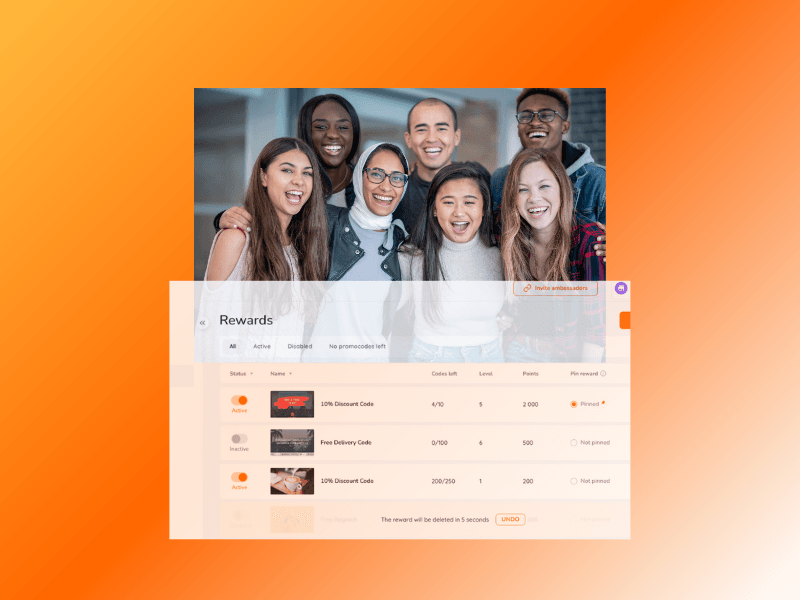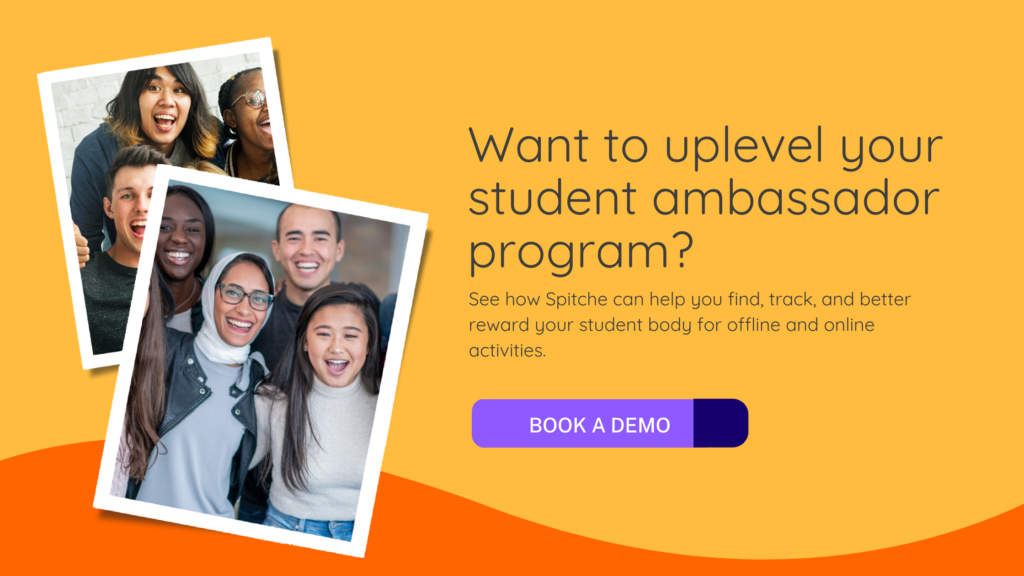
When I went to university, there were always a few individuals on campus who were unusually zealous about school spirit.
They’d want to show everyone around, attend every event, help new and prospective students, and rally at every football game—in school swag, of course.
Their energy was contagious—the more there are people like that, the more people have fun part-taking in school spirit, bringing people into the ecosystem, and even wanting to rock school swag.
If it weren’t for them, most students might be more like me: go to class, do their work, and go home without ruffling a feather. There would be no spirit, and the school would’ve died out a long time ago.
What I didn’t know then is that these students were student ambassadors (or they should’ve been): ambassadors are critical and connecting the student body to the staff, alumni, prospects, and keeping school spirit high and proud.
While most traditional student ambassadors are a hand-picked group of students, new schools are inviting all students, alumni and faculty to be ambassadors, with gamified student ambassador programs.
This blog post aims to explore the multifaceted role of student ambassadors, detailing their contributions and the process behind establishing a successful student ambassador program.

What is a student ambassador?
Student ambassadors are a select group of pupils who play the critical role of liaisons, bridging the gap between the school staff, the current student body, and prospective students considering attendance. These ambassadors embody the spirit and values of the institution, offering a unique and authentic perspective to those exploring their educational options.
While many schools pick and choose their ambassadors from admitted students with great communication skills, leadership skills and a high spirit, you can gamify your student ambassador experience to get more students involved and excited about school spirit and enrollment of new students.
Ambassadors can be the whole student body. ISC Paris, for example, has about 350 students enrolled in the school, and 300 ambassadors in their program (with about 150 active ones). The majority of the school is involved and it helps attract more new full-time students to enroll.

A screenshot of the EAE Business School Ambassador Program signup page
Key responsibilities of a student ambassador
Facilitating communication:
Reaching out to prospective students through calls or emails to provide a personalized touch and answer questions during the admissions process.
Campus Tours and Open Houses:
Leading campus tours and participating in open houses, sharing valuable insights about student life and the campus environment.
Q&A Sessions:
Engaging in question-and-answer sessions with candidates and their families, offering honest responses and sharing personal stories.
Supporting the Enrollment Journey:
Maintaining ongoing communication with newly admitted students, helping to facilitate a smooth transition into school life.
Orientation and Special Events:
Being a familiar and reassuring presence during orientation events and other special activities, ensuring new students feel welcomed and part of the community.
Shadow Days:
Giving prospective students an opportunity to partner with an ambassador during shadow days to experience a day in the life of a student.
Mentorship:
Serving as mentors, especially to first-year students, by offering guidance and sharing personal experiences.
Event Management:
Organizing and taking part in various events and recruitment activities, contributing to the vibrant campus atmosphere.
Outreach:
Engaging in outreach efforts to connect with high school students, international students, and the local community, enhancing the school’s community relations.
Answering Questions:
Providing detailed information about various aspects of student life, admissions processes, and financial aid options to interested parties.
Attending Events:
Student ambassadors can win rewards for attending events. ISC Paris, for example, held several events on their campus in 2023 and even had to turn down students because so many students showed up thanks to their ambassador program.
Social Media Engagement:
You can reward student ambassadors for engaging with your social media accounts and content on Instagram, Facebook and TikTok and other platforms to help your school’s online reputation when prospective students are checking them out.

Benefits for the student body and institution
The benefits of student ambassador programs for both current and prospective students are clear, but not without their challenges.
- Enhancing the Student Experience: Ambassadors are pivotal in making campus life more accessible and supportive. However, ensuring that each ambassador can cater to the diverse needs of the student body can be a learning curve. Many initially underestimate the range of queries and concerns students might have, leading them to adapt training to cover a broader spectrum of student experiences.
- Influence in the Admissions Process: Since the ambassadors are students themselves, it makes for a more relatable and empathetic admissions process. However, but not all prospective students connect with the same narrative. A one-size-fits-all approach in your outreach won’t be as effective. Think of ways to diversify your ambassador team, ensuring a wide range of experiences and backgrounds are represented.
- Driving Enrollment Growth: Ambassadors today use social media and in-person interactions to influence prospective students. However, but that over-reliance on digital platforms can miss the mark with certain demographics. Balancing digital outreach with personalized, in-person interactions was a key lesson, leading to more nuanced and effective enrollment strategies.
- Embodying Institutional Values: While ambassadors are great at promoting the spirit o the institution and fostering a vibrant campus life, there are may be instances where their interpretation of these values differed from the school’s vision. This discrepancy highlighted the need for ongoing dialogue and training to ensure a consistent representation of your school’s ethos.
Selecting and Training Ambassadors
In a traditional student ambassador program or admissions ambassador program, students are hand-selected and placed in a “VIP” group.
Criteria for Selection:
- Candidates should demonstrate strong public speaking abilities, leadership opportunities they’ve seized, and involvement in initiatives like undergraduate research.
- Look for diversity in your ambassadors to reflect your international student body.
Training Process:
- Training covers areas like effective communication, conducting engaging campus tours, and handling typical questions about student life and academic programs.
In next-gen student ambassador programs—all students can participate and be ambassadors. They can be rewarded for offline and online activities with prospective, incoming and new students. Gamifying engagement with tools like Spitche makes it easier to track what each student is doing and who the ambassadors are.
Related Post: 16 Ways to Reward Your Student Ambassadors

Related Reading: How to Promote Your Student Ambassador Program
Measuring Success and Program Adaptation
A crucial aspect of managing a successful student ambassador program is regularly assessing its impact and adapting to evolving needs. Here’s how you can measure success and ensure continuous improvement:
Success Metrics:
- Increased Enrollment of New Students: One of the most tangible measures of success is an uptick in enrollment figures. We closely monitor enrollment trends post various ambassador-led initiatives to gauge their effectiveness. If a noticeable increase in new student registrations is observed following ambassador-led tours or outreach events, it’s a strong indicator of success.
- Positive Feedback from Current Students and Faculty: Feedback from the student body and faculty serves as a vital barometer of the program’s impact. We conduct surveys and focus groups to understand their perspectives on the ambassador program. Positive feedback, especially regarding the ambassadors’ influence on campus culture and student support, marks a successful implementation.
- Enhanced Engagement on Social Media and During Campus Events: Track engagement metrics on social media platforms where your ambassadors actively promote your school. You can easily use dashboards like the Spitche student ambassador dashboard to do this. An increase in followers, interactions, and positive comments are indicative of successful outreach. Similarly, higher attendance and participation rates in ambassador-led campus events signal a thriving program.
Continuous Improvement:
- Regular Updates to Training Materials: Learning from experience, regularly revise your training materials to address new challenges and incorporate best practices. For instance, after noticing a gap in handling specific student queries effectively, you can include additional modules in your training program.
- Adapting Strategies Based on Feedback: Student and faculty feedback are instrumental in shaping your strategies. For example, some programs might initially focus heavily on large-scale events for outreach, but feedback might indicate a preference for more personalized, small-group interactions. Consequently, they adjust your event planning to include more intimate, discussion-based formats.
- Addressing Changing Needs: The needs of students and the dynamics of higher education are constantly evolving. To keep pace, continually reassess the program’s objectives and tactics. For instance, with the increasing importance of digital platforms, many programs have incorporated more digital communication and social media training for your ambassadors.
- Monitoring Trends in Higher Education: Stay abreast of trends in higher education and student engagement to ensure your program remains relevant and effective. This includes adapting to technological advancements, changing student demographics, and evolving educational models.
The success of a student ambassador program is not static; it requires ongoing measurement, reflection, and adaptation. By continuously evaluating and updating your approach, you ensure that the program remains a dynamic and valuable asset to your institution and its students.
The challenges of a diverse student body
The Juggling Act: First off, student ambassadors are students, which means academics take the front seat. It’s a common sight: an ambitious ambassador bogged down by the weight of balancing their leadership role and academic deadlines. The struggle is real, and it’s something you’ll have to face head-on.
The Inclusivity Puzzle: Then there’s the challenge of engaging a kaleidoscope of student groups. We’re talking about a rich tapestry of backgrounds, interests, and experiences. The question is, how do you make sure everyone feels included and heard?
Putting the community in student community
Flexibility is Key: So, how can you tackle the balancing act? Flexibility must be your mantra. Ditch the one-size-fits-all schedule and introduced a ‘choose-your-own-adventure’ approach. With a tool like Spitche, ambassadors can decide how involved they want to be. Ambassadors now tailor their involvement to fit their academic commitments. Plus, you can throw in some neat workshops on time management because, let’s face it, who couldn’t use a bit of that?
Regular Pow-wows: To tackle inclusivity, turn to regular check-ins. These aren’t your run-of-the-mill meetings. They’re brainstorming sessions, feedback fiestas, and idea incubators all rolled into one. The goal? To ensure that your activities resonate with every corner of your diverse student body.
Inclusivity Training: It’s always a good time to up your game in understanding diversity. Enter inclusivity training modules. These aren’t just tick-box exercises. They’re deep dives into understanding and valuing different perspectives, ensuring ambassadors are as inclusive in their approach as they are enthusiastic.
Data-Driven Decisions: Last but not least, embrace data. By tracking who’s participating and who’s not, you get a clearer picture of where we need to focus your efforts. It’s like having a roadmap to student engagement.
Adapt to the new generation of student ambassadors
In a nutshell, managing a student ambassador program is about adapting, learning, and, most of all, listening. It’s a continuous process of tweaking and fine-tuning. But the payoff? A program that’s as diverse, dynamic, and driven as the student body it represents.
The student ambassador program is a vital component in building a cohesive and dynamic academic environment. By nurturing these leaders within your student body, you not only enhance the student experience but also lay a strong foundation for future successes in higher education.
